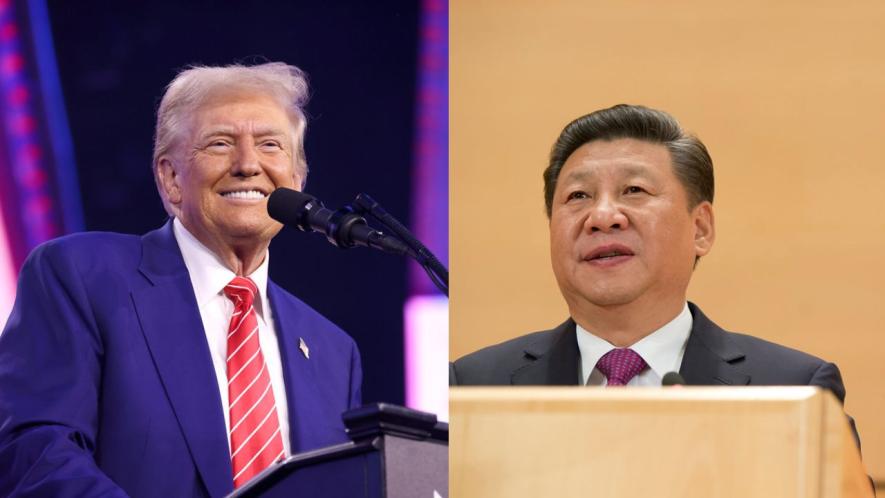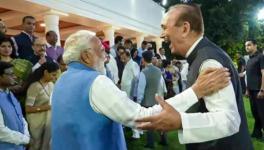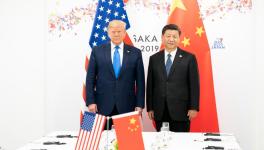Trump’s Tariff War: ‘After Me, the Deluge’

Image Courtesy: Flickr
There are many dimensions of Donald Trump's trade war launched against all countries beginning April, from the biggest countries, such as China, the European Union (EU), Japan, and India, to the smallest, including Lesotho, one of the poorest countries in the world.
Lesotho exports diamonds to the US, has a per capita income of approximately $3.3, and is in no position to buy US goods. The US imposed an import duty on Lesotho of 50%, the highest tariff on any country. This is before China and US reciprocal tariffs tit for tat action reached minimum China’s tariff to 145%.
Trump's absurdities also included imposing tariffs on certain islands in the Antarctic, whose only inhabitants are penguins, and Diego Garcia, which hosts a US military base whose only residents are US soldiers. His tariffs do not spare even countries like Mexico and Canada, which have free trade agreements with the US; or his treaty allies like Germany, France, the UK, Australia, Japan, South Korea, and the Philippines. Countries like India, Vietnam, etc., are in the third circle of “friendship”; if Trump and the US have any friends left!
I am not going to deal with the larger question of why unrestricted trade helps rich countries more than poor ones, why the condemnation of Trump's tariff is correct but for the wrong reason, or what the path of development should be for poorer countries: a form of autarchy or planned engagement with clear goals in mind.
We are in an era when the crisis of global capital shows that the earlier policy of "free" trade and capital flows is not working for even the rich countries. Trump believes that a new strategy is in order, and that strategy is the dystopic brave new economic world he wants to create with his tariff war.
Trump's team believes that to balance the US trade with a country, all they have to do is take a country's trade surplus with the US and divide it by its exports to the US. If negative—meaning that the US has a trade surplus with that country—it will still face a flat 10% tariff as the floor, irrespective of its tariffs on US exports!
If positive, half that ratio becomes the tariff, again with a floor of 10%. In other words, Trump wants to not only profit from all his partners, he also wants to balance his books with every country in the world. This is instead of looking for an overall trade balance in which a country can have a surplus with some countries, while having a deficit with others.
It is this "theory" of trade coupled with the above formulae that wrecked the US stock and bond market, forcing Trump temporarily to take a few steps back. The tariff threat still hangs over the world, while the trade war with China, its biggest trading "partner", continues and has intensified further.
The immediate impact of a unilateral imposition of tariffs led to a crisis in the US stock market, spilling over also to the bond market. The bond market is where US Treasuries—US Treasury Bonds—trade and is even bigger than the stock market. It was the fear of meltdown of the bond market that finally led Trump to blink. Liz Truss, the UK Prime Minster, was forced to resign in 2022 in just 49 days when the UK bond market crashed after her disastrous Budget.
Trump has now announced a 90-day respite for the new US tariffs, within which time frame each country would need to come and negotiate with the US. However, the 10% minimum tariff and certain other tariffs still continue. It was an open declaration that if they wanted a reduction of their tariffs, all countries have to come to Emperor Trump, kiss the ring and negotiate. The 10% minimum tariff was non-negotiable, it would be imposed even if a country had a trade deficit with the US and levied less than 10% or even zero tariffs on US exports to their country.
According to Fitch Rating, even under the new relaxed Trump levies on all imports, the US tariff rate has rocketed to 22% from just 2.5% in 2024 and is the highest since 1910.
Most countries have started negotiations with the US. China refused to play ball with Trump and levied equivalent retaliatory tariffs on US exports to China. This led to further tit-for-tat measures, with the US tariff on China now standing at 145%-175%. The Chinese tariff has been capped at 125% as China believes that after 125% tariffs, trade is virtually impossible, and any further increase is only notional.
When the current trading order was created with the World Trade Organisation—WTO—the advanced countries led by the US believed that with their edge in science and technology, they would control the commanding heights of the global economy. In other words, an international division of labour where poorer countries would produce low-tech goods while they would produce high-tech goods with higher profit margins.
In a dynamic situation, this would mean that as technology advances, the rich countries would advance to even more high-tech products while leaving the less advanced products to the developing countries. Not the complete colonial paradigm of industry with us, and agriculture and mining for you. But a nuanced version of the same. One exception was carved out for the US: it could protect its agriculture in ways others could not.
Even within the WTO regime, the state could still play a key role in developing science and technology, both in building capacity and integration with industry, and climb the ladder faster than the rich countries. The possibility of playing catch-up successfully depended on the State's willingness to invest in technology development—both human and knowledge creation—and how much protection it would offer for the emerging tech sectors.
Let us not forget that even under WTO rules, particularly with some of the Intellectual Property (IP) exceptions that India had fought for in WTO, India could successfully become the global pharmacy of the world. Unfortunately, we are now ceding this place to China as we are not focusing on the developing active pharmaceutical ingredients (APIs), where the key to drug production lies, but only on the final formulation.
In electronics, again, we had a blinkered vision. We decided India would focus only on software, leaving hardware developments to China, South Korea, and Taiwan. As I have written earlier, C-DoT, a government agency, had developed the first digital switch among developing countries, along with South Korea and China.
Unfortunately, we or at least the government planners, believed that software was where real advances would happen and where we should focus. Somehow, the vision that hardware and software could develop together was beyond the scope of our "Brahmanical" thinkers, perhaps with their bias against working with our hands.
Interestingly, the international business press, more accurately the Western business press, e.g., Financial Times, Bloomberg, etc., are all predicting how the US trade war with China will rebound on the US. The Economist has even a quirky headline: How America Could Make China Great Again. It is important to recognise that trade wars are painful for everyone; the key question is, who does it hurt more? In this loss-loss game, Trump is hoping that China will lose more and, therefore, blink first.
Trump and his economic advisers have a simple theory: since the US imports more than twice as much as it exports to China, refusing to buy Chinese goods would hurt China more than the US.
As Adam Posen explains in Foreign Affairs (published by the US Council of Foreign Relations, a US think-tank) and as mainstream American thinking as you can get, this is diametrically opposite to reality. China can sell to others or even to its own people by expanding domestic credit without too much trouble. However, it is more difficult to replace China as a supplier, particularly on a scale that the US needs.
China imports many agricultural products from the US, including soy, oilseeds, and sorghum, which, if it stops buying, will affect Trump's voter base. In other words, China and the US trade decoupling will hurt the US much more than China. In game theory, the ability to inflict more pain on your opponent than you suffer is called escalation dominance. According to Posen, Trade Wars Are Easy to Lose, China has escalation dominance over the US in a tariff fight.
Realising that tech major Apple and other major US manufacturers would suffer serious consequences from the Trump administration's trade war with China, the Trump administration temporarily withdrew some of the 145% duty imposed on Chinese electronic imports, providing immediate relief for Apple iPhone and other laptop manufacturers. However, the sword of Damocles will still hang over them if the US-China trade war continues.
The US-China trade war also makes clear that the trade regime ushered in by WTO is over, buried by the same parties that were interested earlier in a low-tariff world. With China's rise, along with South Korea, South East Asia and India, the so-called advanced countries—more correctly, the ex- and neocolonial countries—are spooked. They want to use their eroding but still significant economic power to turn the trading system into a "heads I win, tails you lose" world.
The problem for the world is that while the West cannot win such a war, it can cause significant damage to the global economy and the economy of all other countries. This is the blackmail that accompanies Trump's tariff regime. The belief is that the West is still militarily stronger than others, and if nothing else works, war is still an option: a form of "After Me, the Deluge" of Louis XV, the King of France delusion. Louis XV's actions led to the French Revolution soon after his death.
Trump could weather six bankruptcies in his career as a builder-cum-real estate operator. Unfortunately, a global economic bankruptcy will be much more unforgiving. Not only for Trump and the US but, unfortunately, for all of us as well.
Get the latest reports & analysis with people's perspective on Protests, movements & deep analytical videos, discussions of the current affairs in your Telegram app. Subscribe to NewsClick's Telegram channel & get Real-Time updates on stories, as they get published on our website.
























